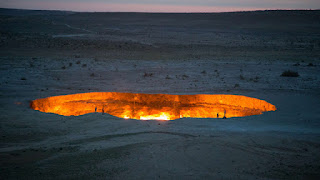“You’re only human” is a phrase used to excuse all manner of sins. But some human errors carry greater, longer-lasting consequences than others. In the 70s, one such miscalculation tested the weight-bearing capacity of an “oil mine”, which later turned out to be a large pocket of natural gas. Having put an immense rig on top of this pocket, the engineers scarpered as a huge crater filled with natural gas formed. Fearful of how the gas might affect neighboring wildlife and communities, a quick fix was settled on. This was to light a fire that would burn off the gas in a matter of weeks. 50 years on, however, those fires are still burning.
Our story begins in the heart of Turkmenistan's Karakum Desert, which was part of the Soviet Union back in 1971. The Soviets were in pursuit of oil fields and having detected what they believed to be a bountiful source in the desert, they mounted a rigging station including a sizable and heavy drill. Once drilling began, it became quickly apparent that they had misjudged the nature of the beast. Instead of drilling into oil, they had set up a hefty operation above an enormous pocket of natural gas. The rig soon collapsed, creating an enormous hole which is now known as the Darvaza crater.
Darvaza was 70.1 meters (230 feet) across and 20.1 meters (66 feet) deep, and its collapse led to a domino effect that saw craters collapsing across the landscape. With each new crater came more natural gas which was mostly made up of methane. This presented a big problem, as methane has an unfortunate habit of soaking up all the available oxygen in the air. Fearing for the lives of local communities and wildlife, the scientists did what so many have done when faced with a problem and tried setting it on fire.
 The collapse of the Darvaza Crater triggered several more in the area. A_Sh/Shutterstock.com
The collapse of the Darvaza Crater triggered several more in the area. A_Sh/Shutterstock.com
There was a method to the madness, as it was expected that burning off the natural gas would take just a few weeks, and then the air quality of the Karakum Desert would continue as normal. Herein lay the next folly, as it was revealed that this was a gross miscalculation, and the flames continue to this day. The flames haven’t stopped burning since they first were lit half a century ago, and scientists still aren’t sure how long they will continue to burn. Popularly known as the “Gates of Hell,” the Darvaza crater and its flaming neighbors attract hundreds of tourists like moths to a literal flame.
Our story begins in the heart of Turkmenistan's Karakum Desert, which was part of the Soviet Union back in 1971. The Soviets were in pursuit of oil fields and having detected what they believed to be a bountiful source in the desert, they mounted a rigging station including a sizable and heavy drill. Once drilling began, it became quickly apparent that they had misjudged the nature of the beast. Instead of drilling into oil, they had set up a hefty operation above an enormous pocket of natural gas. The rig soon collapsed, creating an enormous hole which is now known as the Darvaza crater.
Darvaza was 70.1 meters (230 feet) across and 20.1 meters (66 feet) deep, and its collapse led to a domino effect that saw craters collapsing across the landscape. With each new crater came more natural gas which was mostly made up of methane. This presented a big problem, as methane has an unfortunate habit of soaking up all the available oxygen in the air. Fearing for the lives of local communities and wildlife, the scientists did what so many have done when faced with a problem and tried setting it on fire.
 The collapse of the Darvaza Crater triggered several more in the area. A_Sh/Shutterstock.com
The collapse of the Darvaza Crater triggered several more in the area. A_Sh/Shutterstock.comThere was a method to the madness, as it was expected that burning off the natural gas would take just a few weeks, and then the air quality of the Karakum Desert would continue as normal. Herein lay the next folly, as it was revealed that this was a gross miscalculation, and the flames continue to this day. The flames haven’t stopped burning since they first were lit half a century ago, and scientists still aren’t sure how long they will continue to burn. Popularly known as the “Gates of Hell,” the Darvaza crater and its flaming neighbors attract hundreds of tourists like moths to a literal flame.


Post a Comment